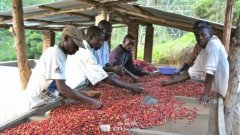Coffee producing area-Yemen
Before the 6th century AD, Yemen was called Arabia, so coffee trees shipped from Yemen to other places were also called Arabian coffee trees. But the origin of these trees is Ethiopia, and the Dutch spread these coffee trees around the world. Dutch businessmen sailing eastward around the Cape of good Hope (The Cape Of Good Hope) travel across the east coast of Africa to the port of Mocha in Yemen before they begin their long trek to India. In 1696, the Dutch introduced coffee trees to Ceylon (now Sri Lanka) and then to Batavia in Java.
Mocha beans are smaller and rounder than most, which makes mocha beans look like peas-in fact, bean-shaped berry coffee beans (Peaberrybean) are sometimes called mocha beans. Mocha beans are similar in shape to Ethiopia's Harrar beans, with small particles, high acidity and a strange and indescribable spicy flavor. If you taste it carefully, you can tell the taste of chocolate, so the attempt to add chocolate to coffee is a natural development.
In Yemen, coffee growers plant poplars to provide shade for coffee to grow. As in the past, these trees are planted on steep terraces to maximize the use of less rainfall and limited land resources. In addition to Tippika Coffee and bourbon Coffee trees, more than a dozen different coffee species native to Ethiopia are grown in Yemen. But even good coffee, such as premium mocha, is air-dried and the peel is connected to the beans. Until now, Yemen often uses traditional stone mills to remove dry and hard shells, which makes the coffee beans irregular in shape and often damages them.
Despite the high quality and smooth aroma of Yemeni coffee, there is something unsatisfactory, that is, the quality can not be continuously guaranteed and the classification of its coffee beans is uncertain. Traditionally, the best coffee beans in Yemen come from Mattari, followed by Sharki, followed by Sanani. These beans are low in caffeine and are exported from December to April of the following year. The problem in the past was that coffee from the north was adulterated before it was shipped from the southern port of Aden. Only coffee shipped from the port of Hodeida can be determined to be genuine from the north. The vast majority of Yemeni coffee is grown in natural conditions, mainly because growers lack funds.
Important Notice :
前街咖啡 FrontStreet Coffee has moved to new addredd:
FrontStreet Coffee Address: 315,Donghua East Road,GuangZhou
Tel:020 38364473
- Prev

Mocha in Yemen
Yemeni mocha is one of the oldest coffee in the world, but until recently, Yemeni mocha has come to be regarded as one of the best and most delicious coffee in the world. Mocha coffee, which has a long history, is synonymous with coffee. Its unique aroma and sour taste have deeply attracted many coffee lovers.
- Next

Yemen, a coffee-producing region in Asia
Mocha Mattari early Yemeni coffee was mainly exported from the port of Mocha, so the coffee that was later exported from here was named after Mocha. In Yemeni coffee, Mattari and Sanani are more famous, among which Matari tastes more full-bodied, with strong acidity and cocoa flavor, while Sanani has more
Related
- Detailed explanation of Jadeite planting Land in Panamanian Jadeite Manor introduction to the grading system of Jadeite competitive bidding, Red bid, Green bid and Rose Summer
- Story of Coffee planting in Brenka region of Costa Rica Stonehenge Manor anaerobic heavy honey treatment of flavor mouth
- What's on the barrel of Blue Mountain Coffee beans?
- Can American coffee also pull flowers? How to use hot American style to pull out a good-looking pattern?
- Can you make a cold extract with coffee beans? What is the right proportion for cold-extracted coffee formula?
- Indonesian PWN Gold Mandrine Coffee Origin Features Flavor How to Chong? Mandolin coffee is American.
- A brief introduction to the flavor characteristics of Brazilian yellow bourbon coffee beans
- What is the effect of different water quality on the flavor of cold-extracted coffee? What kind of water is best for brewing coffee?
- Why do you think of Rose Summer whenever you mention Panamanian coffee?
- Introduction to the characteristics of authentic blue mountain coffee bean producing areas? What is the CIB Coffee Authority in Jamaica?

